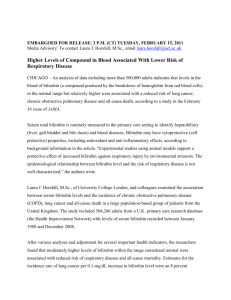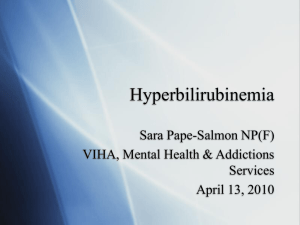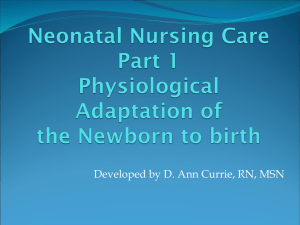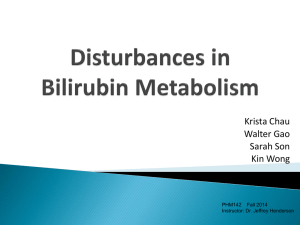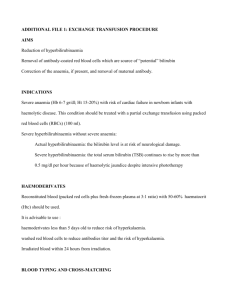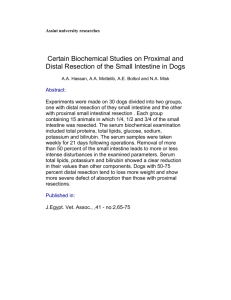1 Background
advertisement
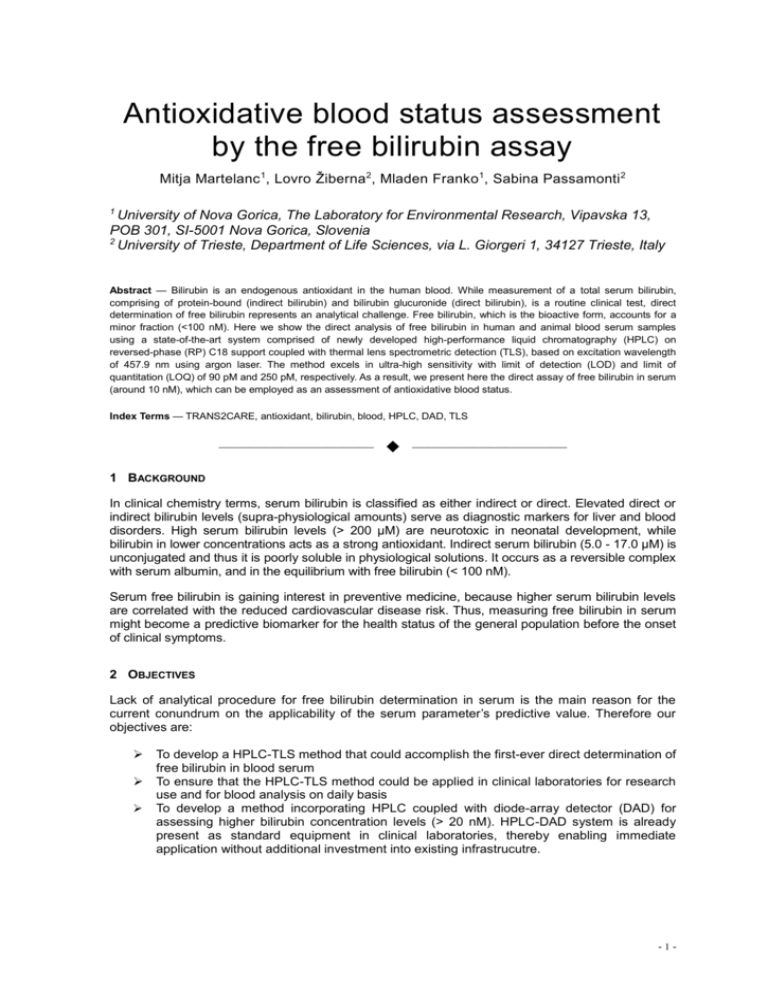
Antioxidative blood status assessment by the free bilirubin assay Mitja Martelanc 1, Lovro Žiberna 2, Mladen Franko 1, Sabina Passamonti 2 1 University of Nova Gorica, The Laboratory for Environmental Research, Vipavska 13, POB 301, SI-5001 Nova Gorica, Slovenia 2 University of Trieste, Department of Life Sciences, via L. Giorgeri 1, 34127 Trieste, Italy Abstract — Bilirubin is an endogenous antioxidant in the human blood. While measurement of a total serum bilirubin, comprising of protein-bound (indirect bilirubin) and bilirubin glucuronide (direct bilirubin), is a routine clinical test, direct determination of free bilirubin represents an analytical challenge. Free bilirubin, which is the bioactive form, accounts for a minor fraction (<100 nM). Here we show the direct analysis of free bilirubin in human and animal blood serum samples using a state-of-the-art system comprised of newly developed high-performance liquid chromatography (HPLC) on reversed-phase (RP) C18 support coupled with thermal lens spectrometric detection (TLS), based on excitation wavelength of 457.9 nm using argon laser. The method excels in ultra-high sensitivity with limit of detection (LOD) and limit of quantitation (LOQ) of 90 pM and 250 pM, respectively. As a result, we present here the direct assay of free bilirubin in serum (around 10 nM), which can be employed as an assessment of antioxidative blood status. Index Terms — TRANS2CARE, antioxidant, bilirubin, blood, HPLC, DAD, TLS —————————— —————————— 1 BACKGROUND In clinical chemistry terms, serum bilirubin is classified as either indirect or direct. Elevated direct or indirect bilirubin levels (supra-physiological amounts) serve as diagnostic markers for liver and blood disorders. High serum bilirubin levels (> 200 µM) are neurotoxic in neonatal development, while bilirubin in lower concentrations acts as a strong antioxidant. Indirect serum bilirubin (5.0 - 17.0 µM) is unconjugated and thus it is poorly soluble in physiological solutions. It occurs as a reversible complex with serum albumin, and in the equilibrium with free bilirubin (< 100 nM). Serum free bilirubin is gaining interest in preventive medicine, because higher serum bilirubin levels are correlated with the reduced cardiovascular disease risk. Thus, measuring free bilirubin in serum might become a predictive biomarker for the health status of the general population before the onset of clinical symptoms. 2 OBJECTIVES Lack of analytical procedure for free bilirubin determination in serum is the main reason for the current conundrum on the applicability of the serum parameter’s predictive value. Therefore our objectives are: To develop a HPLC-TLS method that could accomplish the first-ever direct determination of free bilirubin in blood serum To ensure that the HPLC-TLS method could be applied in clinical laboratories for research use and for blood analysis on daily basis To develop a method incorporating HPLC coupled with diode-array detector (DAD) for assessing higher bilirubin concentration levels (> 20 nM). HPLC-DAD system is already present as standard equipment in clinical laboratories, thereby enabling immediate application without additional investment into existing infrastrucutre. -1- 3 APPROACH & METHODS General approach: 1. Blood collection. 2. Serum preparation. 3. Serum ultracentrifugation. 4. Free bilirubin analysis in ultrafiltrate solution. Methods: Two possible methods for assessment of free bilirubin - by HPLC-TLS or HPLC-DAD methods were used, as recently published [1]. Brief graphical summary of the method is shown in Figure 1. Figure 1: Schematic presentation of ultra-highly sensitive HPLC-TLS system for the determination of free bilirubin in serum samples. Bilirubin limits of detection and quantification are 90 pM and 250 pM, respectively 4 RESULTS By the application of published HPLC-TLS method [1] the determination of free bilirubin is no longer allusive as shown in Figure 2. This opens new frontiers in clinical and pre-clinical investigations of bilirubin. It must be pointed out that the lack of appropriate free bilirubin analysis has so far prevented a full understanding of its physiology. The study revealed that free bilirubin concentrations of healthy adults are around 10 nM, which is in the range of previously reported values obtained either theoretically or experimentally. The intrinsic value of this study method is that it allows a direct detection of bilirubin degradation products even at trace levels, which can be used as an indication of the quality of sample preparation procedure, so its accuracy with respect to other approaches increases. It should be taken in consideration that the HPLC-DAD method developed in this work could be easily applied in clinical medicine for free bilirubin determination in patients having elevated bilirubin levels such as encountered in the case of mild hyperbilirubinemia which does not require the ultra-high sensitivity provided by TLS [1]. Performed validation of both methods together with the sample preparation procedure meets criteria for their application in clinical medicine. ! "#$ A TLS signal (mV) ! "! ! ) $ ! "! ! #$ 1 1 ! "( #$ 1 ! "' #$ ! "( $ ! "' $ ! "! ! ( $ ! "&#$ HPLC-TLS ! "! ! ' $ ! "&$ 1 HPLC-DAD ! "! ! &$ ! "%#$ Absorbance (mAU) ! "! ! *$ ! "%$ ! "! ! %$ !$ #! $ %! ! $ %#! $ &! ! $ &#! $ ' !!$ ' #! $ ! "! #$ ( #! $ (!!$ Time (s) Figure 0.0215 2: Comparison between HPLC-TLS (black line) and HPLC-DAD (red line) analysis of fresh 0.0065 1 represents free bilirubin signal. Evidently, TLS detection has 20-fold human serum sample. Peak BR IXα (4Z,15Z) higher sensitivity when compared to DAD detection 1 B 0.0055 TLS signal (mV) 0.0165 0.0045 & SERVICES 5 POTENTIAL NEW PRODUCTS 2 1 BR IIIα BR XIIIα 0.0035 Product: Measuring free bilirubin in biological samples (including serum samples) using the 0.0115 HPLC-TLS system could become a standard practice in clinical laboratories interested in 0.0025 translational research. We !can carry studies " #$ % ##$ %! out #$ %&#$ %' #$ showing %" #$ &##$ the &! #$ correlation between serum free bilirubin and a given i) physiological condition, such as pregnancy, physical training, fasting, eating or 0.0065 drinking, among others; as well as ii) pathological condition (any disease). 2 Service: accurate and fast free bilirubin analysis in serum samples can be utilized as service for customers such as medical institutions, scientific institutions, SMEs, which would like to do a given 0.0015(and get a given product), as well as to general public, which enables highly-motivated study !" #! " $! ! " $#! " %! ! " %#! " &! ! " &#! " ' !!" ' #! " individuals to check their blood antioxidant status. Time (s) C ! "! ! ( ! $ ) #$ 6 ! "!C!URRENT COLLABORATIONS ( %$ 6.1! "! !With other ! "! ! #' $ researchers 1 2 TLS signal (mV) ! "! !Universities ( #$ ! "! ! #&$Gorica (PP3, Trans2Care), Trieste (LP, Trans2Care), Ca’Foscari Venice The of Nova 3 4 (PP7, Trans2Care), Primorska (PP12, Trans2Care) and the General Hospital of Sempeter (PP6, ! "! ! ' %$ ! "! ! #%$ Trans2Care) form a research consortium on bilirubin in biomedical research. ! "! ! ' #$ ! "! ! ##$ #' ! $ ( ! ! $ ( #! $ ( %! $ ( &! $ ( ' ! $ %! ! $ %#! $ 7 ! "!C!ONTACT OR COLLABORATIONS NEEDED &%$ ! "! ! &#$collaboration with clinical laboratories is needed. Future 2 ! "! ! #%$ ##$ 8 ! "!C!OMMUNICATION TOOLS !$ (!$ *! ! $ *( ! $ #! ! $ #( ! $ Time (s) &! ! $ 4 3 &( ! $ ' !!$ ' (!$ The high level of expertise in the field of analytical chemistry as well as the high level of applicability, quality and performance of the presented methods is disseminated through the high quality scientific publications. This method has been presented to the biomedical community at the University of Primorska (http://www.trans2care.eu/NewsData.aspx?IdNews=68&ViewType=Old&IdType=390), University of Ferrara (http://www.trans2care.eu/NewsData.aspx?IdNews=81&ViewType=Old&IdType=390), NanotechItaly (http://www.trans2care.eu/NewsData.aspx?IdNews=90&ViewType=Old&IdType=390), Slovenian Chemical Day on 12-14 September 2012 (Portorož, Slovenia) and Chemistry towards Biology on 10-13 September 2013 (Trieste, Italy). Dissemination of scientific results using media for the general public (TV Capodistria http://www.youtube.com/watch?v=l7OdLXKGBNw&feature=youtu.be). 9 FUNDS NEEDED 9.1 For basic research (investigation of biological mechanisms): 30.000 € 9.2 For applied research (solutions for real-world problems): 30.000 € 9.2 For pilot & demonstrator activities (to develop a prototype): 90.000 € 10 CONCLUSION Our method opens new frontiers in clinical and pre-clinical investigations of bilirubin physiology. We reveal that free bilirubin concentrations of healthy adults are around 10 nM. It remains to be elucidated what are the concentrations in the patients with some chronic diseases, and also if pharmacological treatments or healthy life style modifications can affect those values. All in all, our service can be useful to solve some unmet medical of wellness needs, which correlate with the antioxidant status of blood. ACKNOWLEDGEMENT This work was supported by the European Regional Development Fund, Cross-Border Cooperation Italy-Slovenia Programme 2007-2013 (strategic project TRANS2CARE). REFERENCES [1] Mitja Martelanc, Lovro Žiberna, Sabina Passamonti and Mladen Franko, Direct determination of free bilirubin in serum at sub-nanomolar levels. Analytica Chimica Acta, 2014, vol. 809, 174-182.
